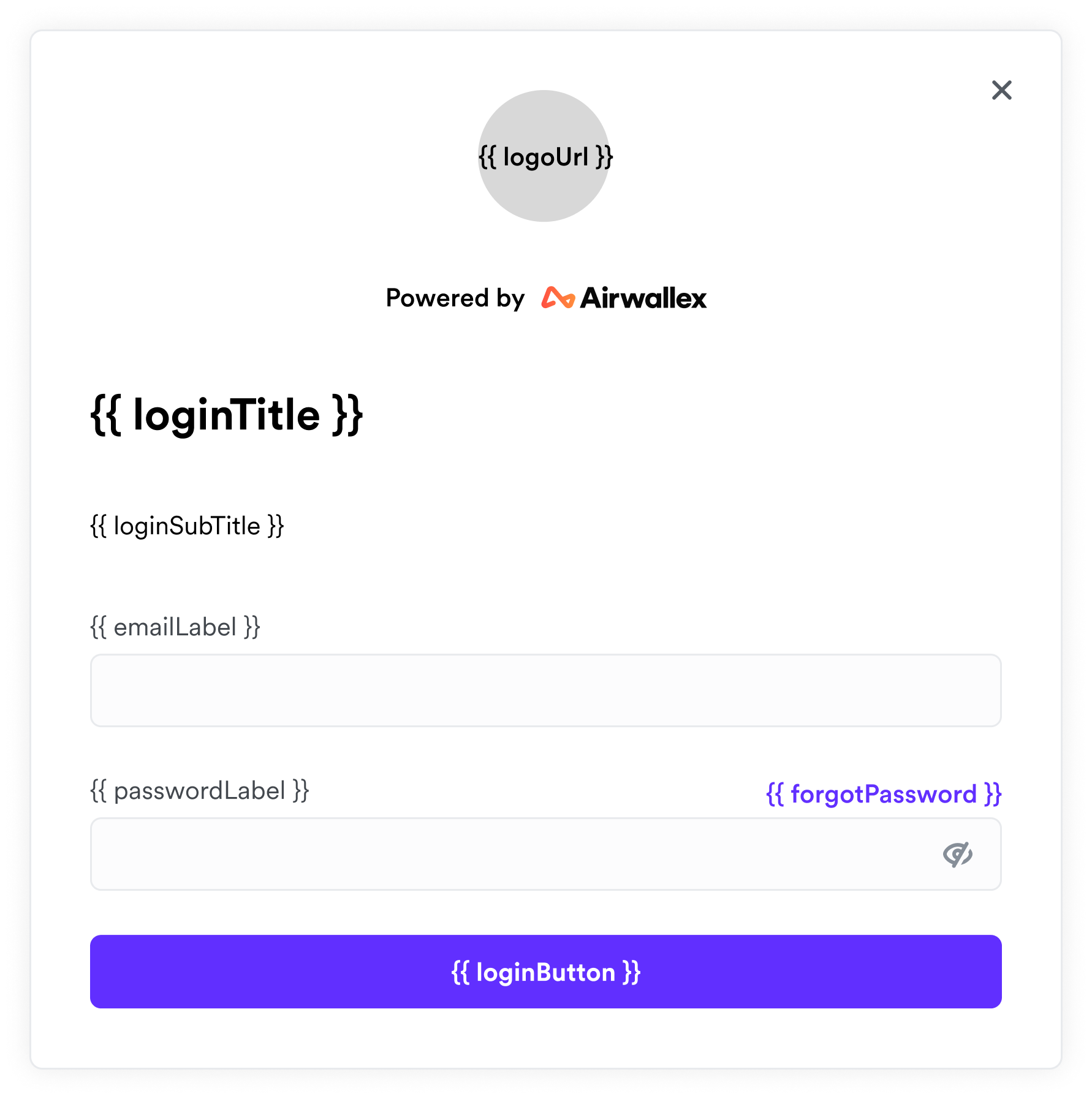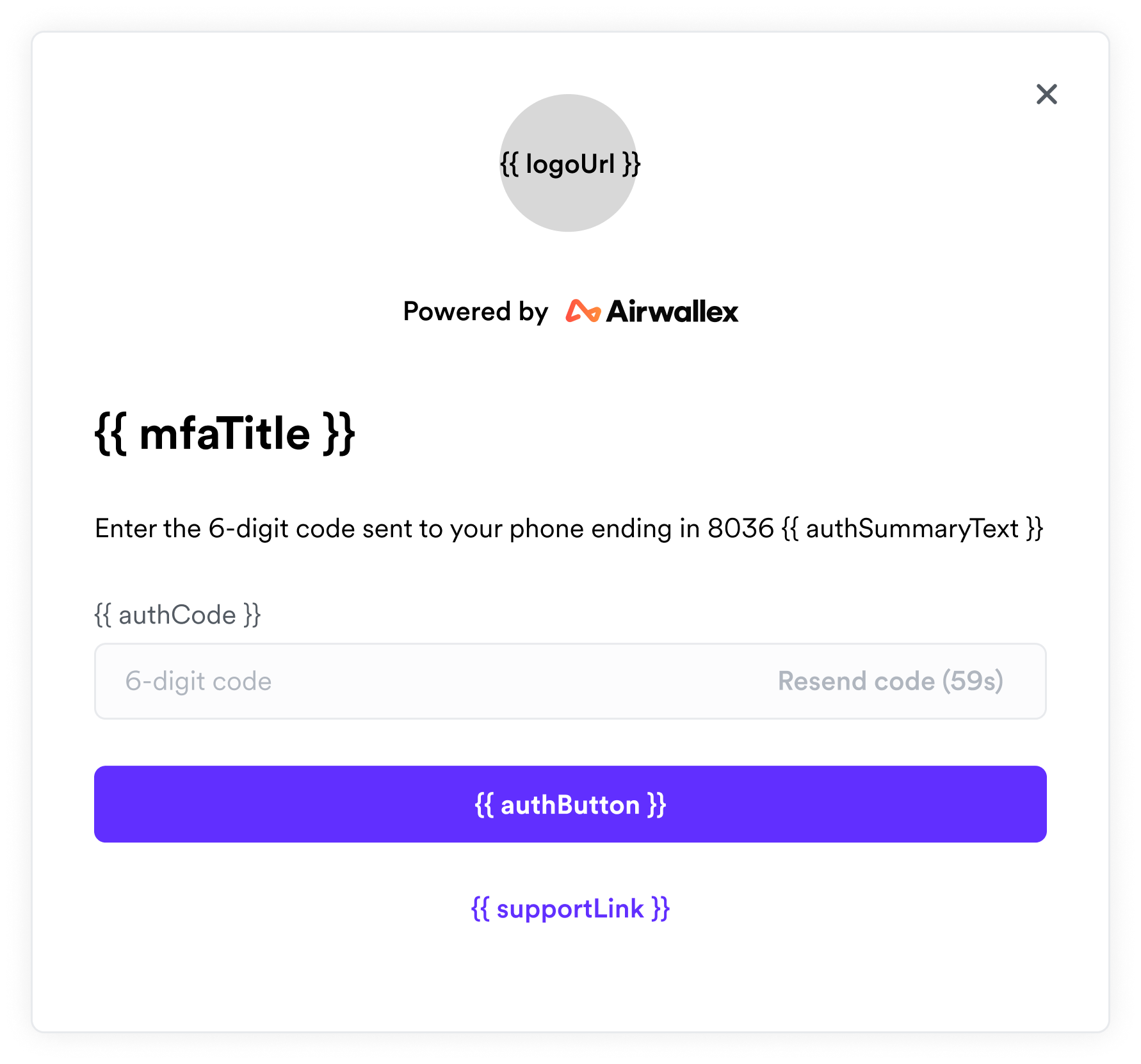README
Airwallex Login Widget
Installation
npm install @airwallex/login-widget
Get Started
Initialize the widget:
import { LoginWidget } from '@airwallex/login-widget';
// Must initialize before creating any login widgets.
// These options will apply to all the login widgets.
LoginWidget.init({
// The URL of the logo to display in the login widget.
// The recommended size of the image is 72x72 px.
logoUrl: 'https://your_website_logo_url',
// The environment of the widget.
env: 'production',
// 'en' or 'zh', these are the supported languages right now
locale: 'en',
});
Create a widget instance:
import { LoginWidget } from '@airwallex/login-widget';
const loginWidget = new LoginWidget({
// These are optional when instantiating the widget,
// but are required before authenticating.
// You could set them later using the widget's `update` method
authSummaryText: 'your_auth_summary_justification_text',
resourceId: 'the_unique_resource_id_to_be_authenticated',
// You could also customize the labels
labels: { emailLabel: 'User name' },
enableDisclaimer: true,
});
Listen to the cancel event, so that when the user clicks the exit button, you could unmount the widget
loginWidget.on('cancel', () => {
loginWidget.unmount();
});
Also remember to listen to the auth success event
loginWidget.on('auth_success', ({ signedToken }) => {
// Do something with the token
});
You will have to create a mask yourself, and mount the widget on top of it:
<div class="mask">
<div id="widget-container"></div>
</div>
loginWidget.mount('#widget-container');
Tips
For better experience mobile responsive friendly, recommend set <meta name="viewport" content="width=device-width, initial-scale=1, shrink-to-fit=no, minimum-scale=1.0, maximum-scale=1.0, user-scalable=no" /> in html head.
LoginWidget
LoginWidget.init
type: (initOptions?: WidgetInitOptions) => void;
interface WidgetInitOptions {
/**
* The URL of the logo to display in the login widget.
* The recommended size of the image is 72x72 px.
*/
logoUrl?: string | undefined;
/**
* The environment of the login widget
* @default 'production'
*/
env?: Environment;
/**
* The language of the login widget.
* @default 'en'
*/
locale?: Language | undefined;
}
type Language = 'en' | 'zh';
type Environment = 'staging' | 'demo' | 'production';
LoginWidget.constructor
type: constructor(options?: LoginWidgetOptions);
interface LoginWidgetOptions {
authSummaryText: string;
resourceId: string;
labels?: LoginWidgetOptionsLabels | undefined;
}
interface LoginWidgetOptionsLabels {
authButton?: string;
authCode?: string;
emailLabel?: string;
forgotPassword?: string;
loginButton?: string;
loginSubTitle?: string;
loginTitle?: string;
mfaTitle?: string;
passwordLabel?: string;
supportLink?: string;
}
LoginWidget.prototype.on
LoginWidget.prototype.on('ready', () => void)
Emitted when widget is ready to use.
LoginWidget.prototype.on('cancel', () => void)
Emitted when the user clicks the exit button.
LoginWidget.prototype.on('blur', (ev: LoginWidgetFieldEvent) => void)
Emitted when the user blurs the field.
LoginWidget.prototype.on('change', (ev: LoginWidgetFieldEvent) => void)
Emitted when the user changes the value of a field.
LoginWidget.prototype.on('focus', (ev: LoginWidgetFieldEvent) => void)
Emitted when the user focuses the field.
interface LoginWidgetFiledEvent {
/**
* Whether the input of the field is valid.
*/
complete: boolean;
/**
* The name of the field.
*/
field: FieldName;
}
type FieldName = 'username' | 'password' | 'authcode';
LoginWidget.prototype.on('login_success', () => void)
Emitted when the user login successfully.
LoginWidget.prototype.on('auth_success', (ev: LoginWidgetAuthSuccessEvent) => void)
Emitted when authentication is successful.
interface LoginWidgetAuthSuccessEvent {
signedToken: string;
}
LoginWidget.prototype.on('error', (ev: LoginWidgetErrorEvent) => void)
Emitted when error occurs.
interface LoginWidgetErrorEvent {
errorCode: string;
message: string;
}
const ERROR_CODE_MAP = {
BAD_CREDENTIAL: 'User name or password is incorrect',
INVALID_AUTH_CODE: 'Invalid authorization code',
INVALID_RESOURCE_ID: 'Invalid resource ID',
TWO_FACTOR_AUTHENTICATION_NOT_ENABLED: 'Two-factor authentication is not enabled',
UNKNOWN_ERROR: 'Unknown error',
USER_AUTH_LOCKED: 'User has been locked due to multiple failed authentication attempts',
USER_LOGIN_LOCKED: 'User has been locked due to multiple failed login attempts',
};
LoginWidget.prototype.removeEventListener
Unsubscribe the event.
type: (eventType, listenerToBeRemoved) => void;
LoginWidget.prototype.mount
Append the widget to the given DOM element.
If the DOM element could not be found, will throw an error.
type: (domElement: string | HTMLElement) => void;
domElement is either a CSS Selector or a DOM element.
LoginWidget.prototype.update
You could also update the widget on the fly.
Every option used to initialize the widget could also be used to update the widget.
type: (options: LoginWidgetUpdateOptions) => void;
interface LoginWidgetUpdateOptions {
authSummaryText?: string | undefined;
resourceId?: string | undefined;
labels?: LoginWidgetOptionsLabels | undefined;
enableDisclaimer?: boolean | undefined;
}
LoginWidget.prototype.unmount
Remove the widget from the DOM.
All event listeners will NOT be removed, they must be removed manually.
type: () => void;
The Customizable Parts

